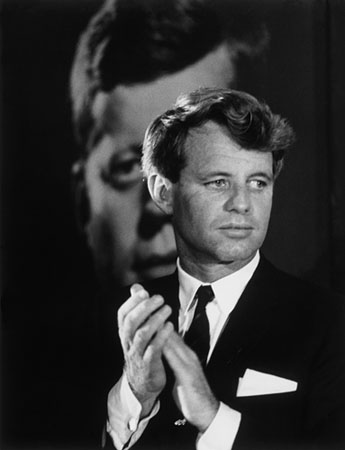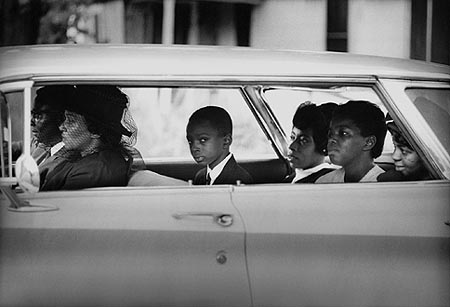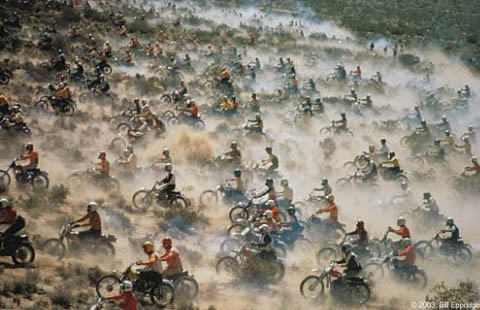Photojournalist Bill Eppridge Has Devoted His Life to Covering "Wars, Riots, and Revolutions"-- and a whole lot more
May 27, 2011 | Source: Monroe Gallery of Photography
The News TimesFairfield Museum hosts photojournalist Eppridge show
Phyllis A.S. Boros, Staff Writer
Published 06:15 p.m., Thursday, May 26, 2011

In this photograph by Bill Eppridge, Sen. Robert F. Kennedy stands in front of a poster of his late brother, President John F. Kennedy, at a Democratic fundraiser at the Ohio Fairgrounds, Ohio, in 1966. This image ran on the cover of Life magazine on Nov. 18, 1966. The renowned New Milford photojournalist is now being honored with a retrospective at the Fairfield Museum and History Center.
Intrepid in his desire to document the world around him, photojournalist Bill Eppridge has devoted his professional life to covering "wars, riots and revolutions" -- and a whole lot more.
In a career that has spanned more than 50 years, Eppridge has managed to capture extraordinary moments in America's political and cultural history for the likes of National Geographic, Life magazine and Sports Illustrated.
His iconic 1968 photos of a dying Robert Kennedy -- lying in a pool of blood on the kitchen floor of the Ambassador Hotel seconds after being shot by Sirhan Sirhan -- are part of the American experience.
Also familiar to millions of Americans are his photos from numerous Winter Olympic games, as well as those from such seminal events from the 1960s and '70s as the Beatles' first visit to America, the Woodstock music festival, the Vietnam War and the funeral of civil right activist James Chaney in Mississippi.

His landmark photo essay for Life that focused on Manhattan's former so-called "Needle Park" inspired the Al Pacino movie "Panic in Needle Park."
And now the renowned photographer has turned his attention to the evocative beauty of old barns found in and around New Milford, where he and his wife live.
More than 65 images from these and other phases of Eppridge's career are now the subject of a three-gallery retrospective at the Fairfield Museum and History Center. The exhibit will be on view through Aug. 28 as part of the museum's Images 2011 celebration.

New Milford photojournalist Bill Eppridge captured this 1971 photo for Life magazine at the start of the Barstow-to-Las Vegas motorcycle race, with 650 entrants, by standing on the skid outside of a helicopter at 500 feet above ground. The photo is included in Images 2011 at the Fairfield Museum through Aug. 28.
In addition to the Eppridge retrospective, Images 2011 also includes the museum's third annual Juried Photography Exhibition, featuring one gallery devoted to more than 70 photos -- all deemed noteworthy by a panel of four judges that included Eppridge --in student and professional/serious amateur adult divisions.
Born on March 20, 1938, in Argentina to American parents (his father was stationed there as a chemical engineer for DuPont), Eppridge spent his formative years growing up in Richmond, Va.; Nashville, Tenn.; and Wilmington, Del.
During a recent telephone chat, Eppridge said that he first became interested in photography at about age 10 for reasons that were anything but altruistic.
"Sibling rivalry -- that's the reason. I have this older sister who has always been a very fine artist. She draws, paints, sculpts -- and I can't draw a straight line. I wanted to do something (creative) so I could compete with her. So I went to her and asked her to show me how to use a camera, and she begrudgingly agreed," he recalled, laughing.
By high school, his interest in photography had blossomed into a full-blown passion. After a short stint at the University of Toronto, Eppridge headed for the University of Missouri's School of Journalism, where he graduated with a major in photojournalism in 1959.
In that same year, while still a student, good fortune would visit Eppridge -- and shape his life for years to come.
"I had this friend who was a horse" at a nearby farm, Eppridge said, as he began a story about shooting an award-winning photo for the cover of this college newspaper's farm supplement.
"This horse knew me . . .Whenever I would drive by, I'd always give him a lump of sugar." So Eppridge headed to the farm to photograph "his friend" when the newspaper's editor announced that he was in desperate need of a last-minute photograph. "But when I got out of the car, I slipped and I spooked him -- and he took off running."
Eppridge had the opportunity to shoot just one photo -- and that photo would become "Stormy, Columbia, Missouri, 1959," a dramatic photograph of a white horse charging through a field with "tornadic" storm clouds in the distance.
That photo won him the National Press Photographer's Award/First Prize Pictorial. And that award, plus the distinction of being named College Photographer of the Year, caught the attention of Life photography director Roy Rowan -- subsequently leading to his long affiliation with the magazine.
"Hard to say whether I made luck happen, or whether luck happened to me," he said, again laughing.
Eppridge said that he has always gotten great joy from plying his art and craft no matter the subject. But he noted that one of the most fascinating periods of his life was spending more than a year on the road with Bobby Kennedy, covering his presidential campaign for Life magazine. He says he came to admire Kennedy enormously -- "I thought he was the right man for the time" -- and documenting his assassination was terribly sad.
But Eppridge said he has remarkable eye-hand coordination (a product he said from playing lots of pinball in college) and shooting those iconic photos of a fallen Kennedy were instinctual.
Renowned in recent years as a teacher devoted to mentoring a new generation of photojournalists, Eppridge says he advises students to "never put that camera down . . . it always has to be with you. And you really, really have to want to do this.
"This is an extraordinary time in history . . . with ideas traveling around the world with incredible speed. It all has to be documented. It has to be done, and as photojournalists, we have to do it."
ANNUAL PHOTOGRAPHY SHOW
More than 650 images from about 220 photographers were submitted for consideration in this year's photography show. From that pool of entries, 71 works from 50 photographers were chosen to be featured in Images 2011 in six categories: abstract, architecture, landscape, nature, photojournalism and portraiture. A regional competition, the event is open to those who work or live in Connecticut, Rhode Island, Massachusetts and New York.
Joining Eppridge on the judge's panel were photo editor Adrienne Aurichio, of New Milford; photographer Stephen Wilkes, of Westport; and photographer/teacher Thomas Mezzanotte, who was Fairfield Arts Center's 2010 Artist of the Year.
Taking top honors in the professional/serious amateur category is Sandy Gennirch, of Stamford, who presented two works: a nature photo, "Horseshoe Crab Ritual," and an abstract "Dry Docked." Her prize is a 10-day exhibition at Southport Galleries at a yet undetermined date.
Winner in the student division is Daria Lombroso, of New Rochelle, who submitted three portraits while a senior at Wesleyan University in Middletown. Her three photos are titled: "Jaime, White Plains," "Tomato and Cheese Sandwich, White Plains" and "Jorge and Andrew, Scarsdale." Lombroso will receive a professional review of her work by Wilkes.
UPCOMING EVENTS
In conjunction with Images 2011, the Fairfield Museum has scheduled several upcoming events including the following:
Screening of PBS American Experience/"Freedom Riders," about the civil rights movement, post-film discussion with artist Tracy Sugarman; Thursday, June 2, 7 to 9 p.m.; free.
"The Soiling of Old Glory: The Power of a Photograph" lecture by Louis Masur of Trinity College, Hartford; Thursday, July 14, 7 to 9 p.m.; $8, students $5.
Behind the Lens guided tours; Thursdays June 23, July 28 and Aug. 18; 10 to 11 a.m.; included with regular admission.
Family Day, with special activities for children, Sundays July 31 and Aug. 21, noon to 4 p.m.; included with regular admission.
The Fairfield Museum and History Center is at 370 Beach Road, behind Fairfield's Independence Hall (exit 22 off Interstate 95). Hours are Monday through Friday from 10 a.m. to 4 p.m., weekends noon to 4 p.m. Admission is $5, $3 for students 6 through 22 years of age and senior citizens; free for children 5 and younger. Call 203-259-1598 or visit http://www.fairfieldhs.org/.
